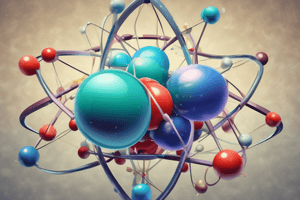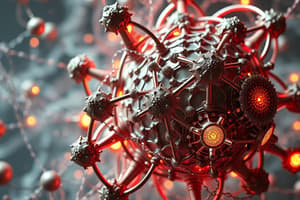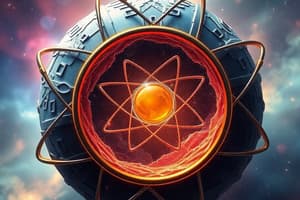Podcast
Questions and Answers
What is the primary use of Cobaltous in silica gel beads?
What is the primary use of Cobaltous in silica gel beads?
- As a catalyst in chemical reactions
- As an indicator in dehydrating agents (correct)
- As an alloying agent in steel production
- As a pigment in artworks
Which of the following metals contains 99.8 – 99.9% pure iron?
Which of the following metals contains 99.8 – 99.9% pure iron?
- Cast Iron
- White Cast Iron
- Gray Cast Iron
- Wrought Iron (correct)
What is the primary component of Ferric Ferrocyanide, commonly known as Prussian Blue?
What is the primary component of Ferric Ferrocyanide, commonly known as Prussian Blue?
- Iron(II) ions
- Iron(III) ions (correct)
- Zinc ions
- Copper ions
What is a characteristic of White Cast Iron?
What is a characteristic of White Cast Iron?
In what form is Osmium commonly used in staining specimens for electron microscopy?
In what form is Osmium commonly used in staining specimens for electron microscopy?
What is the primary physiological form of iron mentioned in the content?
What is the primary physiological form of iron mentioned in the content?
Which form of iron is noted for being the most tolerable and less irritating to the gastrointestinal tract?
Which form of iron is noted for being the most tolerable and less irritating to the gastrointestinal tract?
What key role does ferrous iron play in the body according to the content?
What key role does ferrous iron play in the body according to the content?
Which compound enhances the absorption of iron as stated in the content?
Which compound enhances the absorption of iron as stated in the content?
Ferrous iron is a component of which of the following proteins?
Ferrous iron is a component of which of the following proteins?
Which of the following is NOT a storage form of iron mentioned?
Which of the following is NOT a storage form of iron mentioned?
Which element forms alloys with iron to produce steel?
Which element forms alloys with iron to produce steel?
What is ferrous chloride commonly used for according to the content?
What is ferrous chloride commonly used for according to the content?
What is the atomic mass of a neutron?
What is the atomic mass of a neutron?
Which of the following statements accurately reflects John Dalton's postulates?
Which of the following statements accurately reflects John Dalton's postulates?
What can be concluded about isotopes based on the content?
What can be concluded about isotopes based on the content?
Who discovered the neutron, and how is it significant in atomic structure?
Who discovered the neutron, and how is it significant in atomic structure?
What does the mass number of an element represent?
What does the mass number of an element represent?
In the chemical reaction MgO, what percentage of the compound's mass is contributed by oxygen?
In the chemical reaction MgO, what percentage of the compound's mass is contributed by oxygen?
Which of the following best describes an atom in its uncharged state?
Which of the following best describes an atom in its uncharged state?
What defines the charge of an atom?
What defines the charge of an atom?
What is a method commonly used for removing temporary hardness from water?
What is a method commonly used for removing temporary hardness from water?
Which type of acid is mentioned as a diprotic acid?
Which type of acid is mentioned as a diprotic acid?
Which type of water has a significant quantity of NaHCO3 and Na2SO4?
Which type of water has a significant quantity of NaHCO3 and Na2SO4?
How is carbonated water typically produced?
How is carbonated water typically produced?
Which method is NOT listed for removing insoluble matter from water?
Which method is NOT listed for removing insoluble matter from water?
What is a key characteristic of lithia water?
What is a key characteristic of lithia water?
Which component is primarily involved in the treatment of gastric achlorhydria?
Which component is primarily involved in the treatment of gastric achlorhydria?
Which of these statements is true regarding the use of ion exchange resins?
Which of these statements is true regarding the use of ion exchange resins?
What type of water is characterized by soluble alkali silicates?
What type of water is characterized by soluble alkali silicates?
Which of the following topics is NOT addressed in the context of water quality?
Which of the following topics is NOT addressed in the context of water quality?
Which element is the most abundant metal mentioned?
Which element is the most abundant metal mentioned?
What common toxicity is associated with iodine?
What common toxicity is associated with iodine?
Which gas is the least abundant noble gas?
Which gas is the least abundant noble gas?
What is the common use for Potassium Permanganate (KMnO4)?
What is the common use for Potassium Permanganate (KMnO4)?
Which of the following is NOT present in the atmosphere among the noble gases?
Which of the following is NOT present in the atmosphere among the noble gases?
What is a characteristic of fluorine (F2)?
What is a characteristic of fluorine (F2)?
Which iodine preparation is known for its antibacterial properties and strong iodine content?
Which iodine preparation is known for its antibacterial properties and strong iodine content?
Which superhalogen is recognized as the strongest oxidizing agent?
Which superhalogen is recognized as the strongest oxidizing agent?
What is the main physiological function of manganese (Mn)?
What is the main physiological function of manganese (Mn)?
Which of the following acts as a diluent for medically important gases?
Which of the following acts as a diluent for medically important gases?
What is the antidote for manganese poisoning?
What is the antidote for manganese poisoning?
Which element is the first one produced artificially?
Which element is the first one produced artificially?
Which of the following iodine preparations is formulated for slow release of iodine?
Which of the following iodine preparations is formulated for slow release of iodine?
What is the chemical symbol for the heaviest non-metal mentioned?
What is the chemical symbol for the heaviest non-metal mentioned?
Study Notes
Atomic Structure
- Democritus: Proposed that matter is made up of atoms, the basic unit of matter. These atoms are indivisible and indestructible. Democritus also stated that elements are composed of similar atoms and that different elements have different atoms in terms of size, mass, and other properties.
- John Dalton: Proposed the "Billiard Ball" model of the atom, which posited that atoms are solid, spherical, and indivisible.
- J.J. Thomson: Discovered the electron using a cathode ray tube, which determined the charge-to-mass ratio of electrons.
- R.A. Millikan: Conducted the oil drop experiment, which allowed for the accurate measurement of the charge and mass of an electron.
- James Chadwick: Discovered the neutron, which has no charge and contributes to the atomic mass.
Atomic Model Components
- Protons: Positively charged particles found in the nucleus of an atom.
- Electrons: Negatively charged particles that orbit the nucleus in shells or energy levels.
- Neutrons: Neutral particles located in the nucleus. The mass of a neutron is approximately equal to the mass of a proton.
Atomic Number, Mass Number and Isotopes
- Atomic Number: The number of protons in an atom's nucleus.
- Mass Number: Sum of the number of protons and neutrons in an atom.
- Isotopes: Atoms of the same element that have the same number of protons but differ in the number of neutrons.
Elements
- Fluorine (F2): The strongest oxidizing agent and the most electronegative element.
- Iodine (I2): The heaviest non-metal. It easily undergoes sublimation, producing violet vapor.
- Manganese (Mn): A cofactor involved in protein synthesis, phosphorylation, and fatty acid and cholesterol synthesis.
- Iron (Fe): An important element in engineering and is present in hemoglobin, transferrin, ferritin, and cytochrome oxidase.
- Cobalt (Co): Used as an indicator in silica gel beads.
- Nickel (Ni): Found in fossil fuel combustion and is identified using Dimethylglyoxime Reagent, which produces a red precipitate in ammonia.
- Osmium (Os): The heaviest and densest metal. Osmic Acid (Osmium Tetroxide) is used for staining specimens in electron microscopy.
- Palladium (Pd): Used as a catalyst in finely divided steel.
- Platinum (Pt): Known for its resistance to corrosion and is used as a catalyst in various industrial processes.
Noble Gases
- Helium (He): Used to prepare artificial air and as a diluent for medically important gases.
- Neon (Ne): Primarily used for advertising purposes in neon lights.
- Argon (Ar): The most abundant noble gas and used as a substitute for nitrogen in pharmaceuticals.
- Krypton (Kr): Isolated from argon and has inhalational anesthetic activity.
- Xenon (Xe): An ideal anesthetic inert gas, known for its rapid induction and emergence.
Important Compounds of Iron
- Ferrous Fumarate: A hematinic agent used in the treatment of iron deficiency anemia. It is more stable than ferrous sulphate, more tolerable, and causes less gastrointestinal irritation.
- Ferrous Carbonate: A hematinic used in the treatment of iron-deficiency anemia. It is also known as Chalybeate Pills, Ferruginous Pills, or Blaud's Pills.
- Ferrous Chloride: An astringent and styptic used to detect tannins and phenols. It reacts with morphine to form a blue product and with benzoic acid to form a flesh-colored product.
- **Iron Dextran Injection: ** An Iron supplement administered intramuscularly.
- Iron Oxide: Used as a pigment.
- Iron Pyrite: Known as Fool's Gold.
- Ferric Ferrocyanide: Known as Prussian Blue.
- Ferrous Ferricyanide: Known as Turnbull's Blue.
- Cast Iron/Pig Iron: A crude metal obtained from the blast furnace, containing 92-94% iron.
- White Cast Iron: A solid solution of hard, brittle iron carbide formed when molten iron is rapidly cooled.
- Gray Cast Iron: Formed when liquid iron is poured into sand molds.
- Wrought Iron: A form of iron with a high percentage of pure iron and is highly malleable, ductile, and tough.
Important Compounds of Cobalt
- Cobalt Meta-aluminate: Known as Thenard's Blue and is used to test for the presence of aluminum ions.
- Cobaltous: A compound that is used as an indicator in silica gel beads and other dehydrating agents.
USP Glass Types and Test Limits
- General Type: These are highly resistant borosilicate glass that is used primarily with buffered and unbuffered, powdered, and aqueous solutions.
- Treated Soda: Used for buffered aqueous solutions with a pH range of N = Cl.
- Type I: This is a highly resistant borosilicate glass that provides a high degree of chemical resistance.
Other Important Concepts
- Law of Combining Weights: Chemical reactions can be expressed in small integral proportions by weight.
- Pseudohalogens: These are halogenoids, which resemble halide anions and include CN and CNS.
- Superhalogen: A term coined by Linus Pauling, referring to any species that is more electronegative than any of the halogens.
Water Softening
- Boiling water precipitates calcium carbonate
- Hardness can be removed using ion exchange resins
- Hard water contains calcium and magnesium salts
Chemical Properties of Relevant Acids
- Monoprotic Acids:
- Carbonic acid (H2CO3)
- Benzoic acid (C6H5CO2H)
- Oxalic acid (H2C2O4)
- Acetic acid (CH3CO2H / HOAc)
- Diprotic Acids:
- Phosphoric acid (H3PO4)
- Chromic acid (H2CrO4)
- Triprotic Acids:
- Citric acid (C6H8O7)
Other Water Info
- Alkaline water contains sodium bicarbonate and sodium sulfate (appreciable quantities)
- Saline/purgative water contains high quantities of sodium chloride, sodium sulfate, and magnesium sulfate
- Carbonated water contains calcium and magnesium carbonates that react with acids to release carbon dioxide which results in effervescence.
- Chalybeate water contains iron in solution or suspension
- Lithia water contains lithium carbonate or lithium chloride
- Sulfur water contains hydrogen sulfide, which can deposit sulfur upon atmospheric exposure
- Siliceous water contains soluble alkali silicates
- Baryta water contains barium hydroxide salt solution
Hydrochloric Acid and Salts
- Hydrochloric acid (HCl) is also known as muriatic acid
- Hydrochloric acid is found in gastric juice
- Chief cells secrete pepsinogen, which is converted into pepsin by hydrochloric acid.
- Parietal cells secrete hydrochloric acid.
- Dilute hydrochloric acid is a 10% w/v solution
- Dilute hydrochloric acid is used to treat gastric achlorhydria (low hydrochloric acid levels in the stomach)
- Cobalt Zincate = Rinmann’s Green test for the presence of the Zn ion (beware causes Metal Fume Fever)
Potable Water
- The USP lists methods for making potable water, including distillation, reverse osmosis, and ion exchange.
- Treated water is fit for drinking.
- Insoluble matter in water can be removed via coagulation, settling, and filtration.
- Microorganisms like coliforms in water can be removed by aeration and chlorination.
Studying That Suits You
Use AI to generate personalized quizzes and flashcards to suit your learning preferences.
Related Documents
Description
Test your knowledge on the fundamental concepts of atomic structure, including the contributions of key scientists like Democritus, Dalton, and Thomson. Understand the components of atoms, such as protons and electrons, and their roles in the atomic model. This quiz will help reinforce your learning in chemistry.




